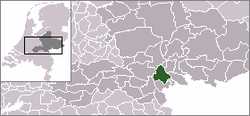Lingewaard
From Wikipedia, the free encyclopedia
| Lingewaard | |||
|---|---|---|---|
| Municipality | |||
_gemeentehuis%2C_voormalig_kloostercomplex.JPG) | |||
| |||
 | |||
| Coordinates: 51°54′N 05°54′E / 51.900°N 5.900°ECoordinates: 51°54′N 05°54′E / 51.900°N 5.900°E | |||
| Country | Netherlands | ||
| Province | Gelderland | ||
| Area(2006) | |||
| • Total | 69.18 km2 (26.71 sq mi) | ||
| • Land | 62.72 km2 (24.22 sq mi) | ||
| • Water | 6.46 km2 (2.49 sq mi) | ||
| Population (1 January 2012) | |||
| • Total | 45,787 | ||
| • Density | 707/km2 (1,830/sq mi) | ||
| Source: Municipality of Lingewaard. | |||
| Time zone | CET (UTC+1) | ||
| • Summer (DST) | CEST (UTC+2) | ||
 Lingewaard (
Lingewaard (![]() pronunciation (help·info)) is a municipality in the eastern Netherlands. It is located in the most eastern part of the Betuwe. It was formed in 2001 as a merger between Bemmel, Gendt and Huissen. The municipality was initially named Bemmel after the largest former municipality but later renamed in a referendum. "Lingewaard" itself is not a population centre, but an artificial name favoured my the majority of the voters. The municipality lies in between of the cities of Nijmegen and Arnhem, where most inhabitants work.
pronunciation (help·info)) is a municipality in the eastern Netherlands. It is located in the most eastern part of the Betuwe. It was formed in 2001 as a merger between Bemmel, Gendt and Huissen. The municipality was initially named Bemmel after the largest former municipality but later renamed in a referendum. "Lingewaard" itself is not a population centre, but an artificial name favoured my the majority of the voters. The municipality lies in between of the cities of Nijmegen and Arnhem, where most inhabitants work.
Population centres
The municipality has the following population centres:
| Cities/villages | Population[1] |
|---|---|
| Huissen | 18.254 |
| Bemmel | 12.577 |
| Gendt | 7.198 |
| Angeren | 2.864 |
| Doornenburg | 2.729 |
| Haalderen | 2.040 |
| Ressen | 119 |
| Loo | 6 |
Notable people
Notable people from the municipality of Lingewaard include:
- Stijn Schaars, footballer, currently at Sporting Portugal (born in Gendt)
Twin towns
Lingewaard is twinned with:
References
- ↑ Inhabitants 1 januari 2012 according to the website of the municipality of Lingewaard.
- ↑ Mizil-Lingewaard Twinning site; accessed September 14, 2010
External links
| Wikimedia Commons has media related to Lingewaard. |
 |
Arnhem, Westervoort | Duiven |  | |
| Overbetuwe | |
Rijnwaarden | ||
| ||||
| | ||||
| Nijmegen | Waal Ubbergen |
Waal / Millingen aan de Rijn |
This article is issued from Wikipedia. The text is available under the Creative Commons Attribution/Share Alike; additional terms may apply for the media files.


